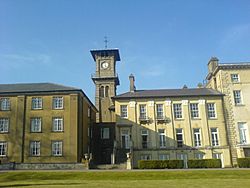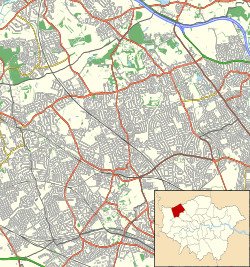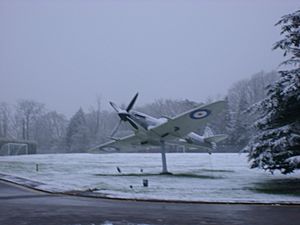RAF Bentley Priory facts for kids
Quick facts for kids RAF Bentley Priory
|
|
|---|---|
| Stanmore, Harrow, Greater London in England | |

The Officers' Mess (now a museum) from the Italian Gardens
|
|
|
Location in London Borough of Harrow
|
|
| Coordinates | 51°37′35.94″N 0°20′3.24″W / 51.6266500°N 0.3342333°W |
| Type | Non-flying administrative station |
| Site information | |
| Owner | Ministry of Defence |
| Operator | Royal Air Force |
| Condition | Closed |
| Site history | |
| Built | 1766 |
| In use | 1936–2008 |
| Fate | Converted to residential use. Former Officers' Mess now the Bentley Priory Museum. |
| Battles/wars |
|
| Garrison information | |
| Past commanders |
|
| Garrison | RAF Fighter Command HQ Royal Observer Corps No. 11/18 Group Strike Command RAF |
|
Listed Building – Grade II*
|
|
| Designated: | 25 May 1983 |
| Reference #: | 1358638 |
| Type: | Grade II |
| Designated: | 9 December 1999 |
| Reference #: | 1001440 |
RAF Bentley Priory was a special place near Stanmore, London. It was a non-flying base for the Royal Air Force. This means planes didn't take off or land there. Instead, it was the main office for RAF Fighter Command during the Battle of Britain and all through World War II.
During the war, the base was hit by some enemy bombs. A V-1 flying bomb and a V2 rocket caused some damage to windows.
RAF Bentley Priory closed its doors on May 30, 2008. All its units moved to RAF Northolt, which is only a few miles away.
The site includes a historic building called Bentley Priory. It was first built in 1766 and made much bigger in 1788. It was even the last home of Queen Adelaide, who was the wife of King William IV. She lived there until she passed away in 1849. After that, the building was a hotel and a girls' school. The RAF bought it in 1926.
Today, the old Officers' Mess building is the Bentley Priory Museum. It shows what the house was like during the Battle of Britain. The land around it has been turned into homes. The area south of the house is now the Bentley Priory Nature Reserve. It's a special place for nature.
Contents
Bentley Priory: A Historic RAF Base
The Priory building and 40 acres of land were sold to the Air Ministry for about £25,000. The rest of the land, about 240 acres, was sold for building homes. The local council bought 90 acres to keep as green space.
In May 1926, a part of the RAF called Inland Area moved into the Priory. It was later renamed 'Training Command'. As the RAF grew, this base became very important for air defence.
The RAF was reorganized in 1936. RAF Fighter Command was created on July 14, 1936. It moved to Bentley Priory with its first leader, Air Chief Marshal Sir Hugh Dowding. Fighter Command stayed at the Priory until 1968.
The Royal Observer Corps' Vital Role
The Observer Corps also moved to RAF Bentley Priory in July 1936. They stayed there until 1995. This group was very important for Britain's air defence. Sir Hugh Dowding said their work was "invaluable" during the Battle of Britain. They tracked enemy planes once they crossed the coast. Without them, air-raid warnings and plane interceptions would have been very difficult.
Because of their great work, King George VI gave the Observer Corps the title "Royal" in April 1941. They became a uniformed volunteer part of the RAF.
The Royal Observer Corps (ROC) was set up to find, track, and report aircraft over Britain. During World War II, they worked with radar systems. Radar tracked planes over water, while the ROC tracked them over land. In 1955, they also started reporting nuclear blasts and fallout. By 1965, they no longer tracked aircraft. They then helped the United Kingdom Warning and Monitoring Organisation (UKWMO) until both groups closed after the Cold War.
The ROC headquarters at Bentley Priory had a small staff. They also had about sixty part-time observers. These observers helped plot aircraft movements in the operations rooms. In 1955, the observers moved to a new center in Watford. By 1968, the ROC headquarters had its Air Commodore, 9 full-time officers, and about 15 civilian staff.
In 1992, a special stained glass window was put in the officers' mess. It marked 50 years since the Battle of Britain. The window shows two observers on duty in London.
Most of the ROC's 10,000 members were stood down on September 30, 1991. Their old banner was placed in St Clement Danes Church in London. A new banner was given by The Queen in July 1991. The Corps was closed because the Cold War ended. The remaining few members were stood down on December 31, 1995. The ROC headquarters at RAF Bentley Priory finally closed on March 31, 1996.
Fighter Command's Headquarters
RAF Fighter Command was led by Air Chief Marshal Sir Hugh Dowding. It had 76 officers, 71 airmen, and 84 civilians. This included the 70 Observer Corps staff.
The main groups under Fighter Command were No 11 (Fighter) Group and the Royal Observer Corps. In 1938, No 3 Balloon Centre was formed nearby. It also worked under Dowding.
Before World War II started in 1939, the Priory changed a lot. The two largest rooms became the Operations Room and the Filter Room. Classrooms were turned into living spaces. Outside, the building was painted brown and green to hide it. Many windows were blacked out.
Dug-outs were built, and sandbags were used for protection. In 1939, the conservatory was removed. It was replaced by wooden offices for the Operations staff. This prepared the Priory for its important role in the war.
The Underground Operations Bunker
In January 1939, work began on an underground Operations Block. It started working on March 9, 1940. It was dug about 42 feet deep.
In spring 1940, Air Chief Marshal Hugh Dowding lived quietly nearby. He walked through the grounds to his office at the Priory every morning. He often met General Frederick Alfred Pile, who led Anti-Aircraft Command. They were good friends and talked about the war. Dowding focused on his work at the Priory. However, he did visit research places and air defences around London when The Blitz started in September 1940.
Dowding's leadership of Fighter Command was very important. He created the Operations and Filter Rooms. These were key parts of the system that helped control air defence. This system allowed controllers to quickly send fighter squadrons to stop Luftwaffe (German air force) raids. This was vital because there weren't enough planes or pilots to keep them flying all the time.
Bentley Priory remained Fighter Command's headquarters throughout World War II. It also became important for planning D-Day. On D-Day, King George VI, Winston Churchill, and U.S. General Dwight D. Eisenhower watched the landings from the Priory's underground bunker.
Dowding's old office in the Officers' Mess still has his desk and papers. These items will stay there as part of the museum.
Anti-Aircraft Command's Role
On April 1, 1939, Anti-Aircraft Command (AAC) was formed. General Sir Frederick Alfred Pile took over its command. AAC moved to 'Glenthorn', a nearby house. Their badge was a 'flexed bow and arrow'. This symbol can still be seen on a silver bowl in the Dowding Room.
The Airstrip at Bentley Priory
As important meetings happened often, an airstrip was needed at Bentley Priory. Air Commodore Richard Atcherley led this project. The Air Ministry said it would take six months to build two 300-yard strips. But the Americans helped, and cinder landing strips were laid in just four days! A hangar was built near the Mess building.
Flight Sergeant Geoff Elphick, a Battle of Britain pilot, flew from the Priory from April 1944. He remembered pulling Air Commodore Atcherley out of a plane that had flipped over while landing. He also quietly cut down some trees that made landings tricky.
Interestingly, a bomber plane almost destroyed the Priory. A Wellington bomber tried to land on the lawns in front of the Priory. It just missed the building and crashed near the Sergeants' Mess. Only one person survived.
Life at Bentley Priory After the War
After the war, the Priory slowly returned to normal. But on March 10, 1947, a fire destroyed the middle part of the building. Two years later, a new bar was built. Princess Elizabeth visited the Priory in 1950.
A wooden building was replaced with a new three-story one. In 1953, a Conference Room was built. The outside of the building was restored in 1954. The Officers' Mess kitchen was also updated.
In 1955, the dining room was made bigger and given a new roof. All this work was finished by 1958. That year, The Queen and other Royal Family members came to the RAF's 40th Anniversary party at Bentley Priory.
Despite the repairs, the building still had problems. In 1964, a report showed that the Ante-Room had dry-rot. It took ten more years to fully check the damage.
In 1966, the clock face was fixed. It was made in 1864 and had a 17-foot pendulum. The clock was lost in a fire in 1979, but the original bells were saved.
On April 30, 1968, Fighter Command joined other commands to form Strike Command. The Fighter Command badge is still above the main entrance. Many silver items in the Officers' Mess still have the Fighter Command Badge.
Bentley Priory also became the main office for RAF Strike Command. However, this moved in 1972. It was also suggested that officer selection should move to the Priory. These plans needed a large Officers' Mess. In 1974, a full check of the building was ordered. The results were worrying: dry-rot was so bad that only the kitchens and dining room were safe. They would also have to close soon.
Around this time, a large underground bunker was built in 1982. It replaced the old World War II bunker.
The Mess had to close, but a special ball was planned. It was for the Royal Air Force Association to remember Fighter Command. Because of the building's problems, tents were used for most of the event. The lower floors were made stronger for a short time. The ball was a big success. The Queen Mother was very interested in the Priory's future. This event helped start a campaign to save the Priory. It was decided to fix it up for about £1 million.
The Fire of 1979
On the evening of June 21, 1979, smoke was seen coming from the Priory. The fire brigade arrived quickly. They tried to fight the fire inside. But the electricity was still on, causing sparks. The firefighters had to pull back. The next morning, they put out the last of the flames. It was found that the fire was an accident.
The fire badly damaged the main staircase. It skipped the Adelaide Room but destroyed other rooms, including the Dowding Room. At first, people thought this was the end for the Priory. But insurance covered most of the rebuilding costs, about £3.1 million.
Even after two fires and many changes, the original design of the house can still be seen. The five columns on the garden side are still there.
Many rooms were built in the 1700s, but most have lost their original look. Only the entrance hall is still mostly the same. It has eight columns and a vaulted ceiling. The 1979 fire removed paint from the ceiling, showing a beautiful pattern. This pattern has since been restored. Another small fire happened in 1980 during the restoration.
Bentley Priory's Closure
RAF Bentley Priory later housed the Defence Aviation Safety Centre, Air Historical Branch, and RAF Ceremonial. Since there was no long-term military use for the site, the Ministry of Defence decided to sell it. This was part of a plan to combine military sites in London.
The plan was to create a main site at RAF Northolt. Units from London would move there, and extra sites would be sold. So, the units at Bentley Priory moved to RAF Northolt in 2008. About £180 million from selling sites was put back into RAF Northolt.
A final dinner for Battle of Britain veterans was held in July 2007. It celebrated the building's role in stopping Hitler's planned air invasion in 1940. There was a special ceremony and a flypast by planes.
The official closing ceremony took place on May 30, 2008. The RAF flag was lowered for the last time. The station officially closed the next day.
Bentley Priory Museum: A Look Back
The old Bentley Priory Officers' Mess became the Bentley Priory Museum in September 2013. It includes the original office of Air Chief Marshal Sir Hugh Dowding. He was the leader of Fighter Command during the Battle of Britain. His office is kept just as it was, with its original furniture.
The Museum also has other important items from the Battle of Britain. This includes one of the few remaining Battle of Britain Lace Panels.
There are also "trophies" that the Royal Air Force took from the Luftwaffe (German air force) after World War II. These include an eagle statue and a statue of Hermann Göring.
The Officers' Mess was also known for its many Royal Portraits. There were two of The Queen. One was in the Dining Room when she was young. The other was in the Ladies' Room. It was paid for by the Royal Observer Corps to celebrate their 50th anniversary. It shows The Queen in her ROC uniform with the Italian Gardens in the background.
There was also a portrait of The Duke of Edinburgh (in a flying suit). A portrait of King George VI was in the Abercorn Bar. And a portrait of The Queen Mother was in the rotunda. She gave it to the Mess after she paid for repairs after a fire. This portrait was surrounded by pictures of many Battle of Britain Pilots. All these portraits are now kept in the Museum.
Images for kids
-
Shared grave in Pinner New Cemetery of the five Free Czechoslovak airmen whose Wellington crashed at Bentley Priory in 1940





